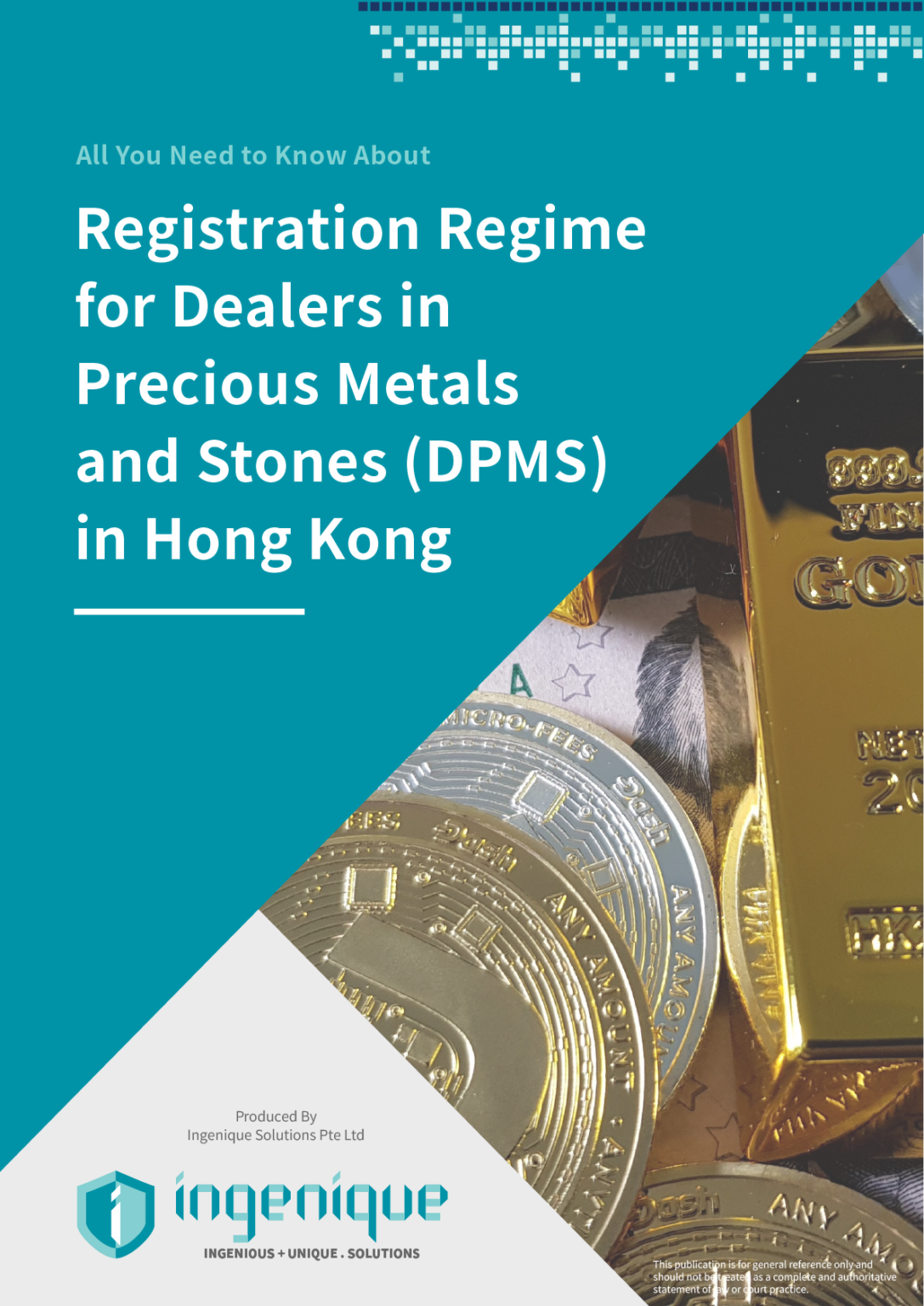updated on 30/01/2024

The Hong Kong Legislative Council passed the Anti-Money Laundering and Counter-Terrorist Financing (Amendment) Bill 2022 on 7 December 2022, to introduce a registration regime for Dealers in Precious Metals and Stones (“DPMS”), so as to impose statutory anti-money laundering and counter-terrorist financing (“AML/CTF”) obligations on DPMS sector.The new DPMS registration regime is regulated by the Customs & Excise Department (the “C&ED”) and came into effect on 1 April 2023.
For more information on the details and highlights of the regulations, please read the article Hong Kong Registration Regime for Dealers in Precious Metals and Stones (DPMS). This article mainly focuses on DPMS Category B registration process, tips on how to register for free, the practical guide on implementing anti-money laundering, and a useful AML/CTF tool for DPMS to mitigate money laundering and terrorist financing (“ML/TF”) risks.
Related Articles:
- Hong Kong Registration Regime for Dealers in Precious Metals and Stones (DPMS) — Details and highlights of the regulations
- SentroWeb — The Best AML Software For Hong Kong DPMS
 |
Download Free WhitepaperAll you need to know about: |
Two-tier Registration Regime for DPMS in Hong Kong
Under the new DPMS registration regime, any person who intends to engage in a business of dealing in precious metals and stones in Hong Kong with cash or non-cash transactions of HK$120,000 or more is required to register under either Category A or Category B with the Commissioner of Customs and Excise (“C of C&E”). Registrants engaging in cash transactions at or above HK$120,000 will fall under Category B and be subject to the AML/CTF obligations under Schedule 2 to the Anti-Money Laundering and Counter-Terrorist Financing Ordinance (“AMLO”). For dealers who only conduct transactions below HK$120,000, no registration is required.
It should be noted that the specified cash transaction of HK$120,000 or more here refers to either the transaction being executed in a single operation, or in several operations that are linked or appear to be linked. In other words, even if a single cash transaction of HKD 120,000 is paid in multiple installments, it is still considered a cash transaction of HKD 120,000 or above and requires Category B registration.
Requirements of Category B Registration
General Requirements
- Applicants must hold a valid business registration certificate or hawker licence
- Applicants must provide the address of the place of business in Hong Kong and correspondence address
Fit and Proper Persons
Applicants, including individuals, partners, directors, and ultimate owners, are required to satisfy a fit and proper test. To meet the “fit and proper person” criteria, the applicants should not have been convicted of any AML/CTF offences locally and overseas, or undischarged or subject to any bankruptcy, winding up or liquidation proceedings, or violate any AML/CTF regulations.
Business Plan and Anti-Money Laundering Policy
- A business plan, indicating the organization structure and resources for AML/CTF policies, are required for registration, including:
i. Company structure and nature of business
ii. Types of products or services, buying and selling, import and export, processing, storage and delivery procedures (if applicable)
iii. Payment method and settlement
iv. Breakdown of customer
- Applicants must develop an anti-money laundering policy, setting out identification, assessment and effective control measures to mitigate ML/TF risks, including:
i. taking a risk-based approach
ii. customer due diligence (“CDD”)
iii. record keeping
iv. review of anti-money laundering and terrorist financing systems
v. staff training
vi. reporting suspicious transactions
vii. other AML/CTF measures (e.g. appointing compliance officers)
Click here to check out Anti-Money Laundering Policy Template for DPMS.
Application Process of Category B Registration
- Submit the application and upload documents via DPMS Registration System (“DRS”), in person or by post
- Settle registration fee
- Verification of application documents, fit and proper test and interviews
- Receive application results
- Upon successful registration, applicants can download the certificate of registration and branch certificates in DRS system, and must display the certificates at the principal place of business, each branch, temporary booths and websites.
Effective Date and Transitional Period
The two-tier DPMS registration regime has been taken effect on 1 April 2023. DPMS who have been in operation before 1 April 2023 is allowed 9 months to apply for registration by 31 December 2023. DPMS who start operating after the commencement of the regime is not allowed any transitional period.
DPMS Registration Fee
The fee for the first registration for Category A is HK$260 with a validity of 1 year, followed by an annual renewal fee of HK$195.
A Category B registration will be valid for three years with a registration fee of HK$1,970, and renewable upon expiry with a renewal fee of HK$1,060. A fit and proper test of HK$650 will be charged for each person for the first as well as the renewal registration.
How to Do Anti-money Laundering for DPMS
i. Risk-based Approach
DPMS are advised to adopt a risk-based approach, based on the business activities, operating models, and customer types, to identify, assess, understand, and take proportionate actions to mitigate ML/TF risks. Below are some common factors for risk assessment:
(a) Customer Risk
e.g. the customer is a politically exposed person (“PEP”) or is listed in sanction lists, significantly uses cash in transactions, or payment made by or delivery of products to third parties.
(b) Country/ Geographic Risk
e.g. the customer resides or his business operates in high-risk jurisdictions, that are subject to United Nations (“UN”) sanctions or identified by Financial Action Task Force (“FATF”) as having deficient systems to prevent ML/TF.
(c) Product/ Service Risk
e.g. the customer buys high-value and easily portable jewellery, opens gold accounts for transferring gold to destinations worldwide.
(d) Delivery Channel Risk
e.g. non face-to-face transactions
ii. Implementing Anti-Money Laundering Policy
When applying for Category B registration, DPMS need to submit a business plan and anti-money laundering policy that outlines the organization’s structure and resources for combating money laundering and terrorist financing, as well as a set of internal AML/CTF policy and measures as guidance for management and staff. DPMS is obligated to ensure that employees are familiar with the policy and it is reviewed and updated regularly.
To fast track the development of the anti-money laundering policy document for applying for registration, you can now purchase a template designed for the DPMS industry. The templates are delivered in Microsoft Word/ Excel format, and are almost 90% complete for your company to use. Training will also be provided for guiding you to customize the template to balance the company’s needs and AML/CTF regulatory requirements. Learn more about the AML Policies, Procedures and Controls (APPC) Template for DPMS here.
iii. Customer Due Diligence Measures
Category B DPMS are required to undertake customer due diligence (also known as “Know Your Customer”) when involved in any cash transaction with a customer of or above HKD 120,000. DPMS should identify and verify the customer identity based on documents, data or information from reliable and independent sources, to ensure they are not subject to sanctions, and to identify if they are PEP or being reported in adverse media. If there is a beneficial owner or the customer purports to act on behalf of his/ her customer, the identity of the beneficial owner and representative must also be identified and verified.
Conducting Customer Due Diligence can be difficient when involving real-time trading with only very limited time for AML/CTF checks. Some anti-money laundering tools such as SentroWeb can help. Check out the details in the “Anti-Money Laundering Tool for DPMS” section below.
iv. Ongoing Monitoring of Customers
Continuous monitoring, including identity documents, source of funds and business activities, helps DPMS to keep track of your long-term customers’ activities and detect unusual or suspicious activities. The frequency of review should be based on the principle of risk-based approach and followed the company’s internal “Anti-Money Laundering Policy.”
Ongoing monitoring can be time-consuming and tedious, and may be impossible to handle manually, especially in small companies or with a large number of customers. Leveraging on RegTech anti-money laundering tools with automated ongoing monitoring function can save a lot of time and cost. Read the “Anti-Money Laundering Tool for DPMS” section below to learn more.
v. Record Keeping
DPMS are required to keep records (in paper or electronic form) of their customers with whom they have carried out transactions of HK$120,000 or above in cash, including transaction data and information, customer due diligence reports, data and information obtained for identifying and verifying the identity of the customer or beneficial owner, and files relating to a customer’s account (if any) and business correspondence with the customer and beneficial owner. The records must be kept for at least 5 years after the transaction.
vi. Suspicious Transaction Reports
If a DPMS identifies or suspects that a customer is involved in proceeds of crime or terrorist property, they must promptly submit a suspicious transaction report to the Joint Financial Intelligence Unit (“JFIU”). Submission can be made through the online platform “Suspicious Transaction Report Management System” (STREAMS) by request.
Anti-Money Laundering Tools for DPMS
Considering the challenges faced by DPMS in implementing anti-money laundering measures, especially when frontline retail staff facing customers or conducting real-time transactions during exhibitions, The FATF encourages the use of technology, such as commercial anti-money laundering tools with Regtech, for immediate screening of customers or customer due diligence.
SentroWeb is one of the reputable anti-money laundering platforms, offering efficient and effective AML/CTF solutions for complying DPMS Category B registration and Hong Kong AML/CTF requirements. By utilizing SentroWeb’s AML search engine, conducting real-time screening of customers during face-to-face transactions can be easier than ever. You can instantly screen customers against global sanctions lists, watchlists, and PEP information with just entering their names. SentroWeb also supports batch searches of up to 1,000 names to minimize manual effort for due diligence for pre-exisitng customers.
With the automated ongoing monitoring feature, your customers’ name are being monitored automaticlly and you will be notified when their names match the latest sanctions and watchlists, resulting in an 80% improvement in operational efficiency and reduction in AML/CTF compliance costs. All search results and risk assessments are recorded on the platform and can be exported for future audits and regulators’ reviews.
SentroWeb is supported by the internationally recognized Dow Jones database from reliable and independent sources reviewed by a professional team. The database is updated daily with high accuracy, covering over 3 million records worldwide, including United Nations, US, and global sanctioned and blacklisted individuals and entities, PEP and their relatives/close associates.
If you are seeking AML/CTF tools for your DPMS registration, contact us for a free consultation and demo of our SentroWeb anti-money laundering software today.
Reference Links
- Passage of Anti-Money Laundering and Counter-Terrorist Financing (Amendment) Bill 2022 on 7 Dec 2022
- Report of the Bills Committee on Anti-Money Laundering and Counter-Terrorist Financing (Amendment) Bill 2022
- Anti-Money Laundering and Counter-Terrorist Financing (Amendment) Bill 2022 (English Version)
- Anti-Money Laundering and Counter-Terrorist Financing (Amendment) Bill 2022 (Chinese Version) 《2022 年打擊洗錢及恐怖分子資金籌集 ( 修訂 ) 條例 草案》
- Public Consultation on Legislative Proposals to Enhance Anti-Money Laundering and Counter-Terrorist Financing Regulation in Hong Kong
- Legislative Council Brief – Anti-Money Laundering and Counter-Terrorist Financing (Amendment) Bill 2022
- Dealer in Precious Metals and Stones Registration System (“DRS”)
- The best AML software SentroWeb for Dealers in Precious Metals and Stones in Hong Kong



